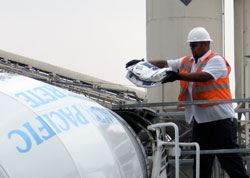Concrete is an excellent building material. It is strong, versatile, inexpensive and available just about everywhere. Concrete is used to build structures ranging in scale from patio stones to hydroelectric dams. When concrete does deteriorate though, it is generally due to the penetration of water.
There are several systems out there that set out to eliminate this water penetration, and among the most effective, efficient and maintenance free is crystalline technology. Sheet membrane products continue to hold a majority market share in the UK though, and despite several advancements in material and application methods over the last 30 years, a membrane still provides insecure protection.
Such systems can be compromised by a single puncture or tear, and carelessness during backfilling and compacting can damage the sheeting; strict schedules and cost restrictions mean such damage will often go unreported and unrepaired. Water entering behind the membrane will lead to loss of adhesion and potential failure at the seams. They also add an unnecessary process to a build schedule.
Installation can also be challenging and the opportunity for poor workmanship is high. Membranes require a clean and dry surface, which must also be smooth and even. The membrane must be carefully wrapped around corners and protrusions and pipes and other penetrations require skilful cutting and lapping. Opportunity for failure, risk of high cost repair and liability for the contractor are all unacceptably high.
 Crystalline technology is an alternative, and for new build concrete structures, a crystalline admixture is ideal. The admixture comprises chemical compounds that react with available water and partially reacted cement particles within the concrete, and generate the growth of long, prism shaped crystals inside the capillary pores, cracks and joints of the concrete.
Crystalline technology is an alternative, and for new build concrete structures, a crystalline admixture is ideal. The admixture comprises chemical compounds that react with available water and partially reacted cement particles within the concrete, and generate the growth of long, prism shaped crystals inside the capillary pores, cracks and joints of the concrete.
These crystals block the passage of water, and as micro-structures they are comparatively rigid and strong – thus they will withstand extreme hydrostatic pressure and ensure the concrete is entirely waterproof.
Man-hours, the need for specialist skill, risk of failure, liability and whole-life cost are all minimised, and long term effectiveness remains perfect as the compound lies dormant indefinitely within the concrete. If a new crack should form in the concrete and water begin to penetrate, the chemicals will react to form new crystals at the leaking location and grow to shut off the flow of water – the concrete has the ability to self-repair cracks of up to 0.5mm.
The result is no liability issues, and no distraction from the other demands of the project. Repair and maintenance costs are minimised, and the project manager has peace of mind – the structure they have built is 100% waterproof, and always will be.
contact@ferncoenvironmental.com
Source: http://www.fca-magazine.com/